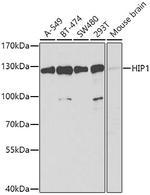Search Thermo Fisher Scientific
图: 1 / 1
HIP1 Antibody (PA5-93288) in WB

产品信息
PA5-93288
种属反应
宿主/亚型
分类
类型
抗原
偶联物
形式
浓度
纯化类型
保存液
内含物
保存条件
运输条件
RRID
产品详细信息
Immunogen sequence: SELEADLAEQ QHLRQQAADD CEFLRAELDE LRRQREDTEK AQRSLSEIER KAQANEQRYS KLKEKYSELV QNHADLLRKN AEVTKQVSMA RQAQVDLERE KKELEDSLER ISDQGQRKTQ EQLEVLESLK QELATSQREL QVLQGSLETS AQSEANWAAE FAELEKERDS LVSGAAHREE ELSALRKELQ DTQLKLASTE ESMCQLAKDQ RKMLLVGSRK AAEQVIQDAL NQLEEPPLIS CAGSADHLLS TVTSISSCIE QLEKSWSQYL ACPEDISGLL H; Positive Samples: A-549, BT-474, SW480, 293T, Mouse brain; Cellular Location: Cytoplasm, Cytoplasmic vesicle, Endomembrane system, Nucleus, clathrin-coated vesicle membrane
靶标信息
Huntingtin disease, a neurodegenerate disease, is caused by the expansion of a polymorphic glutamine tract in huntingtin. The Huntingtin Interacting Protein 1 (HIP-1) is a reportedly proapoptotic, cargo-specific adaptor protein that may be involved in the pathogenesis of Huntingtin disease. As well as playing a role in Huntingtin disease, it is likely to be involved in the recruitment of clathrin coats to lipid membranes and it may also factor in tumorigenesis by allowing the survival of precancerous and cancerous cells. Since HIP-1 expression is significantly associated with prostate and colon cancer metastasis, HIP-1 can serve as a putative prognostic factor for prostate and colon cancers.
仅用于科研。不用于诊断过程。未经明确授权不得转售。
篇参考文献 (0)
生物信息学
蛋白别名: HIP I; HIP-1; HIP-I; hip1; Huntingtin-interacting protein 1; Huntingtin-interacting protein I
基因别名: 2610109B09Rik; A930014B11Rik; E130315I21Rik; HIP-I; HIP1; ILWEQ; Kiaa4113; mKIAA4113; SHON; SHONbeta; SHONgamma
UniProt ID: (Human) O00291, (Mouse) Q8VD75
Entrez Gene ID: (Human) 3092, (Mouse) 215114



